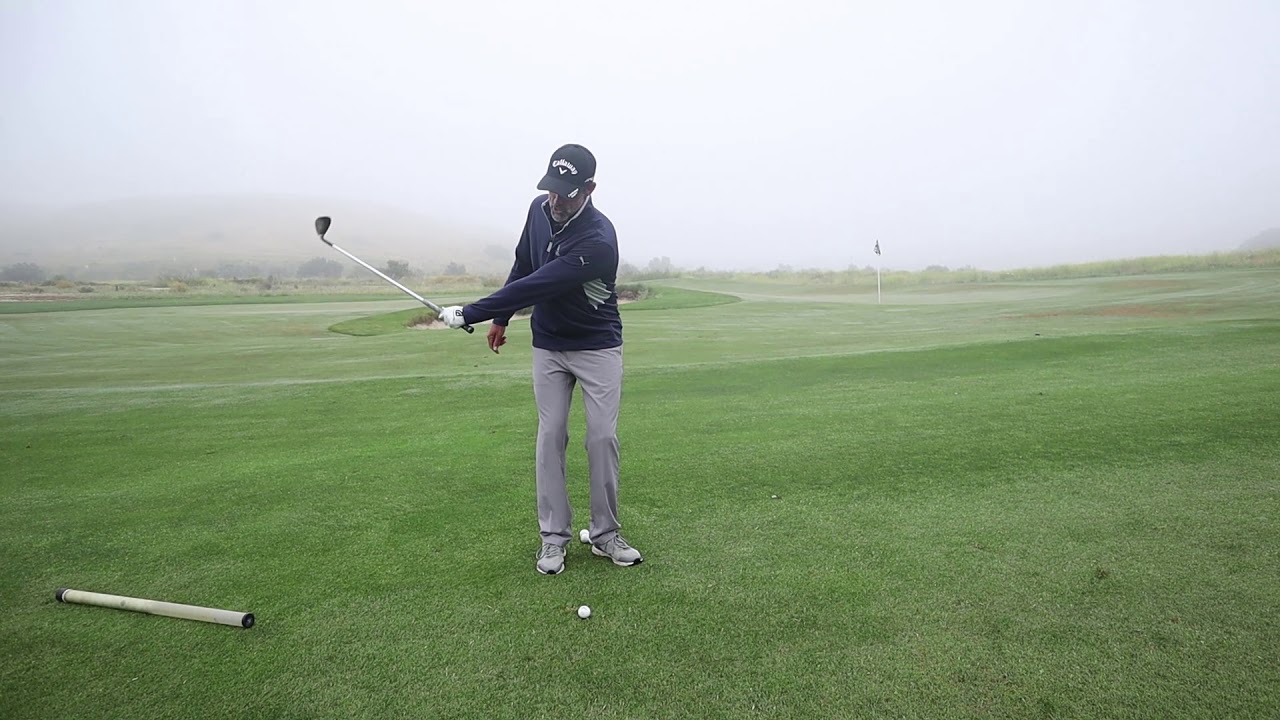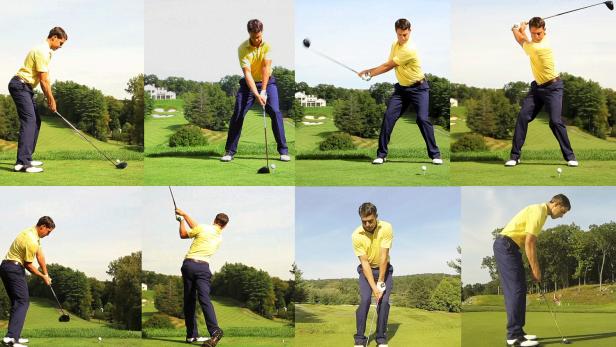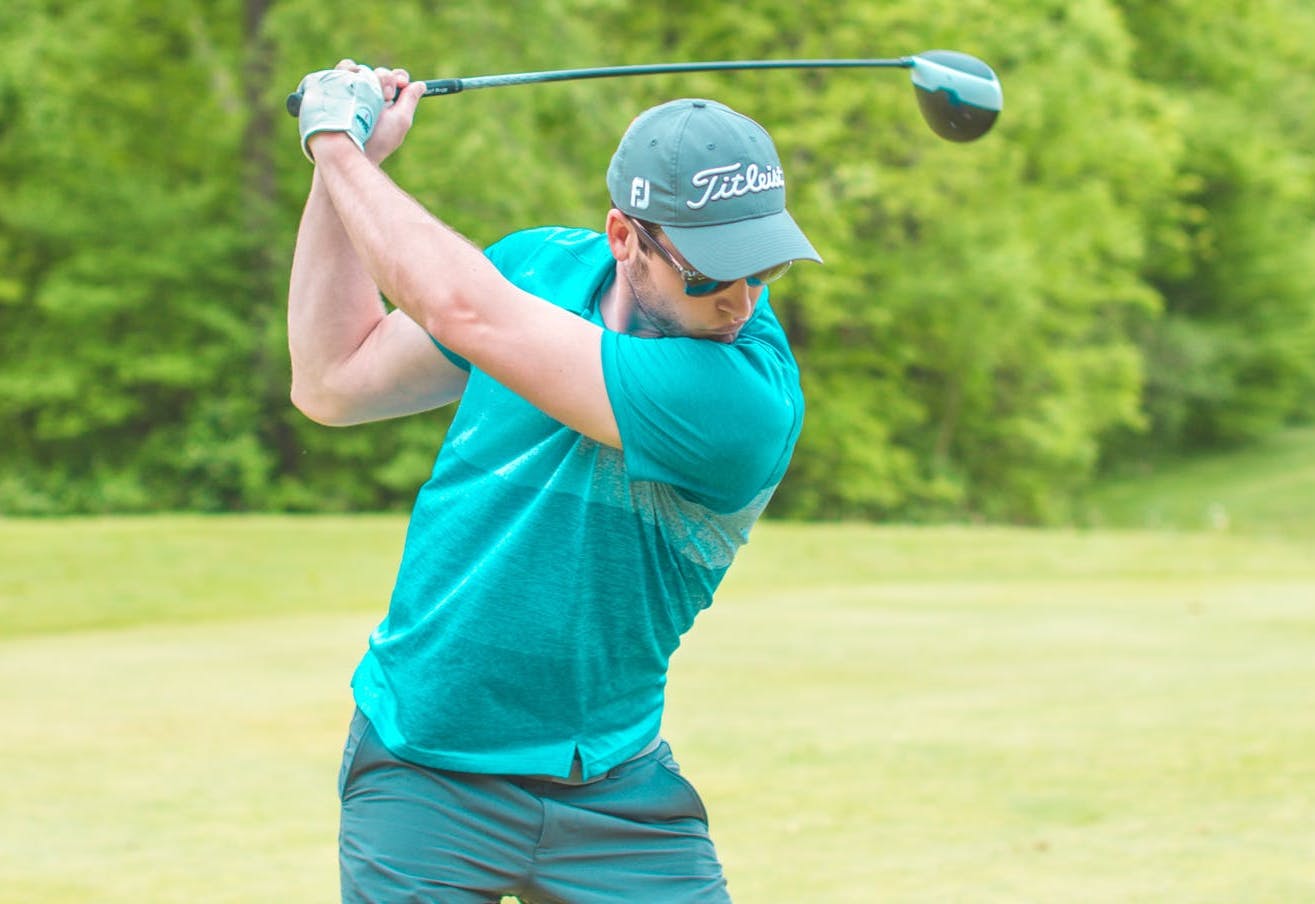
Standing correctly is key to correctly swinging a golf club. Stand with your feet shoulder-width apart, keeping the ball at the center of your stance. You should ensure that your hands are neutral. Your trail and lead feet should be equally spaced. Your lead hip should be slightly angled towards the target.
Backswing
Learning how to backswing a golf club requires understanding a few basic principles. The golf club swings on an inclined plan. Keep your hands free and loose as the club head turns. A slight wrist break should occur at this point as well. The club shaft should be parallel with the ground, and the club head slightly outside of the golf ball.

Proper grip
Strike a golf club with a firm, but relaxed grip. This will give you control over the club and allow you to swing it full-speed. You should feel minimal 'give' when your hands are relaxed and there should be no tension in your forearms or shoulders. The last three fingers of your left hand are the main parts of the grip. If you keep your hands relaxed and in line, you'll be able create more power when swinging and hit the ball farther.
Weight transfer
You should shift your weight towards your feet when swinging a golf ball. This will make it more dynamic. You can lose balance and fall forward when you do this too often. It is best to distribute your weight more to the balls of the feet than to the heels. The latter will keep you from rotating your hips as well as flexing your knees. You will learn the correct weight distribution by practicing.
Optimal ball position
For proper spin and flight, golf requires that the ball be in the best position possible. The center should also be where your swing is centered. It doesn't matter which position you take, the important thing is to know where to place the ball in order to get the best results. This position does not have a specific measurement or name. This is because different players will have different requirements. We will be discussing the factors that impact ball position, and how to get it.
Practise on the range
One way to improve your game on the range is to practice swinging a golf club. Visualize a hole and a target. Line up the fairway. This is a great technique to practice different types of shots and making minor technical adjustments. To keep practice sessions exciting, pick a different target every time. Instead of using the same target every time, make them unique by aiming for different distances.

Taking lessons
Before you can enjoy the benefits of a golf club swing lesson, you need to know the basics of the game. A quality backswing is the key to power and accuracy. It is important to spend time improving your backswing's technical aspects. A golf instructor will be able to help you make the most of the time you spend working on your swing. Your lesson will have been completed and you will be hitting the golf ball like a pro.
FAQ
How is golf played?
Golf is played 18 holes on a course. The Rules of Golf govern the game.
The first stroke is taken from behind a designated teeing area. The course is divided into several holes, where players alternate hitting the balls. Each hole is different depending on the distance to the teeing areas.
There are three types main shots in the game golf:
-
Drive shots are where players use clubs to hit a ball as far as they can. This type of shot is generally considered the most important shot in the game.
-
An approach shot is when players aim to hit the ball within a specified range of the hole.
-
A putt, where players attempt to sink the ball into the cup by rolling it along the ground.
Each hole must be completed by the player who has put all his/her putts in. For each putt not made, the player loses one stroke.
A player may choose to play with a caddy or partner who will carry the club around during a round. The caddie has no influence on the outcome of the match, but they can give advice about strategy or etiquette.
How can I learn how to play golf?
Golf is a skill that takes practice and time. But, you can improve your game. Here are some tips to help:
-
Practice regularly. Golf requires concentration and constant attention. You won't improve your golf skills if you don’t practice enough.
-
Play with others who are skilled at playing. Playing with other people helps you develop your own style of play.
-
Before you start practicing, read about golf. This will give you an idea about what you need to do.
-
You don't have to be able to do everything at once. Start by focusing on one aspect of your game. Try focusing on one area of your game. For example, you might try to improve your putting or learn how to chip. When you feel confident, you can move on to other areas of your game.
-
Take lessons. Lessons can teach you important things like stance, swing speed, posture, etc.
-
Try new techniques. Experiment with new grips and stances.
-
Keep records. Keep track and log your scores. This way, you can identify areas where you need improvement.
-
Join your local golf club. There are many clubs that offer free lessons. These clubs usually have friendly members who are happy to show newcomers the ropes.
-
Find a coach. A coach can offer guidance in certain areas.
What are the various types of golf courses available?
Golf courses come in all shapes and sizes. Some are for beginners and others for experienced players.
Some golf courses are close to lakes, rivers, mountains and forests. Others are found in urban areas. You will find everything from public golf courses to private estates.
Is golfing dangerous?
While golf isn't considered dangerous, it can cause injuries. If you are swinging a club, for example, your arm might be broken.
However, most injuries can be caused by falling from your golf trolley.
Statistics
- They do this by means of assessing and rating courses according to the average good score of a "bogey golfer," a player with a handicap of around 20. (en.wikipedia.org)
- They do this by means of assessing and rating courses according to the average good score of a "bogey golfer," a player with a handicap of around 20. (en.wikipedia.org)
- Buying a set of Titleist or Taylor-Made irons for nearly $1,000 is simply not necessary and likely a waste of money. (golficity.com)
- Professional golfers typically make between 60% and 70% of greens in regulation. (en.wikipedia.org)
External Links
How To
How To Improve Your Putting Game
Golf has been played for hundreds of years. It was invented in ancient Egypt. It has spread across Europe, Asia, America, and then to America. Golf is a sport that requires many skills such as strength, agility, flexibility, coordination, eye-hand coordination, and concentration.
A good level of physical fitness is essential in order to play well. You must also know how to swing well and hit the ball accurately. This will improve your ability to balance and time when you touch the ball.
There are several ways to improve your putting game. You can improve your putting game by practicing regularly, especially before you play in a tournament. You can also use the "putter trainer," a type of training device. This will help you improve your posture and your muscles can bend down or straighten again. It improves your eyesight, muscle control, and eye coordination.
Grip pressure is another factor that can affect your ability to putt. You will soon tire your hands if you hold the club too tightly. You may lose power if your hands are too tight. Your grip pressure should change depending on what type of shot you are playing. For example, if the hole is short, you should apply more pressure to the clubhead, but less force if the green is long.
Your wrists should be relaxed. This will allow you to move your arms and shoulders more freely during strokes. The wrist movement should be smooth and fluid. Watch videos and read books on the subject to improve your putting skills. For tips, ask other players.